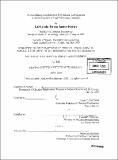| dc.contributor.advisor | Paula T. Hammond and Gareth H. McKinely. | en_US |
| dc.contributor.author | James-Korley, LaShanda Teresa | en_US |
| dc.contributor.other | Massachusetts Institute of Technology. Dept. of Chemical Engineering. | en_US |
| dc.date.accessioned | 2006-03-29T18:33:51Z | |
| dc.date.available | 2006-03-29T18:33:51Z | |
| dc.date.copyright | 2005 | en_US |
| dc.date.issued | 2005 | en_US |
| dc.identifier.uri | http://hdl.handle.net/1721.1/32319 | |
| dc.description | Thesis (Ph. D.)--Massachusetts Institute of Technology, Dept. of Chemical Engineering, 2005. | en_US |
| dc.description | Includes bibliographical references. | en_US |
| dc.description.abstract | Silk-inspired segmented polyurethanes containing flexible, hydrophilic segments with crystalline and liquid crystalline moieties were developed to mimic the hierarchical morphology of the continuous domain in and the superior mechanical properties of native spider silk. A series of polyurethane elastomers were designed with varying poly(ethylene oxide) (PEO)-containing soft segment lengths and hard segment contents. The incorporation of a hydrophobic poly(propylene oxide) (PPO) block and longer soft segment lengths (1900 g/mol) induced a higher degree of micro-phase segregation compared to PEO (1000 g/mol) soft segment polyurethanes of similar hard segment content. Segmented polyurethanes with longer PEO soft segment lengths (4600 g/mol) exhibited a lamellar morphology, which was driven by the high level of crystallinity in both the hard and soft domains. As the hard segment content (26 - 47 wt%) was increased, the crystallinity of the hard domains was enhanced, yielding a shift in the morphology of the continuous domain from soft segment continuous to hard segment continuous or an interconnected microstructure. The mechanical behavior of these systems was affected by the continuous domain morphology. Hysteresis and initial moduli increased, and extensibility decreased as the hard segment size was varied from 26 to 47 wt% in the PEO-PPO-PEO-containing polyurethanes. The pure PEO (1000 g/mol) soft segment polyurethane exhibited enhanced extensibility, tensile strength, and toughness compared to the PEO-PPO-PEO segmented polyurethanes, which was attributed to the presence of load-bearing crystallites. | en_US |
| dc.description.abstract | (cont.) Shearing of the highly ordered and hydrogen-bonded hard domains resulted in orientation of the hard blocks at a preferential angle (±70⁰) to the stretch direction during tensile deformation. Strong alignment and strain-induced birefringence of the soft segment chains was identified in the pure PEO 1000 soft segment polyurethane, which supported the observed mechanical behavior. An ordered mesophase was observed in the PEO-PPO-PEO soft segment polyurethane in which the soft block formed the continuous domain. The hard segments aligned ±30ÌŠ to the elongation direction within the hard domain as a result of the hydrogen-bonded network structure. Dramatic reductions ( [approx.] 16-fold decrease in toughness and [approx] 6-fold decrease in extensibility) in mechanical properties were found in PEO-PPO-PEO soft segment polyurethane/Laponite nanocomposites. The soft segment mobility was restricted in these nanocomposites, diminishing the ability for strain-induced ordering and hindering slippage of the soft segment chains during deformation. Regions of exfoliated Laponite alternated with intercalated-and-flocculated clay regions. These findings were rationalized in terms of preferential attraction of the hydrophilic, PEO-based soft block to the hydrophilic Laponite discs, leading to the intercalated-and-flocculated structures. However, the Laponite particles also interact with the polar hard domains, which has been assigned to the observed exfoliation. Poly(gamma-benzyl-L-glutamate) (PBLG)-PEO-PBLG copolymers were developed using custom-synthesized, diamine-terminated PEO 1000. | en_US |
| dc.description.abstract | (cont.) These copolymers exhibited both alpha-helix and beta-sheet conformations, depending on the PBLG block length. Only low molecular weight segmented polyurethanes were obtained using these liquid crystalline copolymers due to the possible low reactivity of the amine end-groups and cyclization within the PBLG block. | en_US |
| dc.description.statementofresponsibility | by LaShanda Teresa James-Korley. | en_US |
| dc.format.extent | 157 leaves | en_US |
| dc.format.extent | 8338009 bytes | |
| dc.format.extent | 8346854 bytes | |
| dc.format.mimetype | application/pdf | |
| dc.format.mimetype | application/pdf | |
| dc.language.iso | eng | en_US |
| dc.publisher | Massachusetts Institute of Technology | en_US |
| dc.rights | M.I.T. theses are protected by copyright. They may be viewed from this source for any purpose, but reproduction or distribution in any format is prohibited without written permission. See provided URL for inquiries about permission. | en_US |
| dc.rights.uri | http://dspace.mit.edu/handle/1721.1/7582 | |
| dc.subject | Chemical Engineering. | en_US |
| dc.title | PEO-containing copolymers as polyurethane soft segments in the development of high performance materials | en_US |
| dc.title.alternative | Polyethylene oxide-containing copolymers as polyurethane soft segments in the development of high performance materials | en_US |
| dc.type | Thesis | en_US |
| dc.description.degree | Ph.D. | en_US |
| dc.contributor.department | Massachusetts Institute of Technology. Department of Chemical Engineering | |
| dc.identifier.oclc | 61367616 | en_US |
